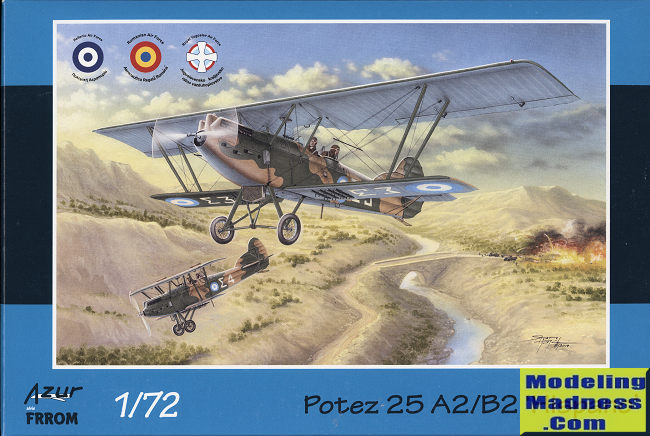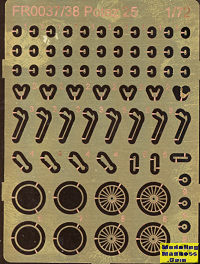Azur/FRROM 1/72 Potez 25 A2/B2 Hispano
|
KIT #: |
FR0038 |
|
PRICE: |
$ |
|
DECALS: |
Four options |
|
REVIEWER: |
Scott Van Aken |
|
NOTES: |
2019 tooling. Short run with
p.e. |

Potez 25 (also written as Potez XXV) was
a French twin-seat, single-engine biplane designed during the 1920s. A
multi-purpose fighter-bomber, it was designed as a line aircraft and
used in a variety of roles, including fighter and escort
missions, tactical bombing and reconnaissance missions. In the late
1920s and early 1930s, Potez 25 was the standard multi-purpose aircraft
of over 20 air forces, including French, Polish and American. It was
also popular among private operators, notably mail transport companies.
2,500 aircraft were built in France with license production taking place
in Yugoslavia, Poland and Romania as well as other countries.. The
popularity of the type was in part due to the airframe being able to be
adapted to a variety of engines. This particular kit provides the option
to build a Hispano powered aircraft.
 Azur/FRROM
kits are all made by the MPM/Special Hobby group. This one is typical with
the molding in a light grey plastic. As the base sprues are used for other
variants, you'll fine several parts not used in this boxing, which is for
the Hispano powered aircraft. Typical of these sorts of kits, you will need
to drill some holes and fill
Azur/FRROM
kits are all made by the MPM/Special Hobby group. This one is typical with
the molding in a light grey plastic. As the base sprues are used for other
variants, you'll fine several parts not used in this boxing, which is for
the Hispano powered aircraft. Typical of these sorts of kits, you will need
to drill some holes and fill
 a bit
to properly portray this variant. The instructions show you exactly where
this needs to be done so it would be wise to actually read through it before
starting. The photo etch fret is fairly extensive. It consists of the wire
wheels, control actuators and rigging attachment points. This latter feature
is the first I've seen in a kit of this scale.
a bit
to properly portray this variant. The instructions show you exactly where
this needs to be done so it would be wise to actually read through it before
starting. The photo etch fret is fairly extensive. It consists of the wire
wheels, control actuators and rigging attachment points. This latter feature
is the first I've seen in a kit of this scale.
Construction starts logically with the interior and is quite complete with
both the pilot and observer/gunner's positions. In addition to the rear gun
(which is on a Scarff ring and installed near the end), you are provided
with a camera. Fuselage is in left and right halves with a separate bottom.
The forward fuselage is also separate to deal with the different engines.
Two cowling options are provided depending on the markings option you
choose. Attaching the upper cowling pieces traps a set of cabane struts. Lower wings
are a single piece and while the 'hills and valleys' may be a bit much for
some, this can be sanded or even filled in if you wish.
One thing to note is that one of the options is for a parasol version of
this aircraft without the lower wing. The construction sequence for that
option will be different from the other three so be sure to pay attention.
There is no rigging diagram for this option so I have to assume that only
the cabane struts are rigged. Not having a lower wing also precludes the use
of the bomb racks.
Once the nose is attached, then comes the upper wing. Some of these planes
had fuel tanks attached and the instructions guide you through that. All the
other struts are single pieces so some sort of jig would probably be useful.
Next the tailplanes are attached and the landing gear made up. Not all
options use wire wheels so you need to know which set of markings you'll be
using fairly early. If you do pick the wire wheels, you'll need to replace
the axle stubs with something thinner.
 One of the final steps is rigging. The kit provides wire attachment areas in
the p.e. set. You are also provided a complete rigging diagram for the
biplane options. After that,
one attaches the bomb
racks and bombs if you are using those as well as the gun and the proper
propeller depending on the markings option chosen.
One of the final steps is rigging. The kit provides wire attachment areas in
the p.e. set. You are also provided a complete rigging diagram for the
biplane options. After that,
one attaches the bomb
racks and bombs if you are using those as well as the gun and the proper
propeller depending on the markings option chosen.
Instructions are excellent and in color. It provides Gunze paint references.
First is the box art plane with the Greek air force in 1941 during the
German invasion. Next we have two Romanian planes, one of which is a parasol
wing version. Finally a Yugoslav version from 1928. All but the Greek plane
are in overall dark green. The large decal sheet is very
nicely done. I've darkened it a bit so you can see the white bits.
It is great seeing interwar planes being kitted.
Especially this one as it was used so widely in the late 1920s and the 1930s.
There will be additional boxings for sure so that you can build other
variations.
https://en.wikipedia.org/wiki/Potez_25
October 2019
Copyright Modeling Madness.com. All rights reserved.
My thanks to Azur/FRROM
for the review kit. Get yours today at your local
retailer or ask them to order it in for you.
If you would like your product reviewed fairly and fairly quickly, please contact the editor
or see other details in the
Note to
Contributors.
Back to the Main Page
Back to the Review
Index Page
Back to the Previews Index Page


 Azur/FRROM
kits are all made by the MPM/Special Hobby group. This one is typical with
the molding in a light grey plastic. As the base sprues are used for other
variants, you'll fine several parts not used in this boxing, which is for
the Hispano powered aircraft. Typical of these sorts of kits, you will need
to drill some holes and fill
Azur/FRROM
kits are all made by the MPM/Special Hobby group. This one is typical with
the molding in a light grey plastic. As the base sprues are used for other
variants, you'll fine several parts not used in this boxing, which is for
the Hispano powered aircraft. Typical of these sorts of kits, you will need
to drill some holes and fill
 a bit
to properly portray this variant. The instructions show you exactly where
this needs to be done so it would be wise to actually read through it before
starting. The photo etch fret is fairly extensive. It consists of the wire
wheels, control actuators and rigging attachment points. This latter feature
is the first I've seen in a kit of this scale.
a bit
to properly portray this variant. The instructions show you exactly where
this needs to be done so it would be wise to actually read through it before
starting. The photo etch fret is fairly extensive. It consists of the wire
wheels, control actuators and rigging attachment points. This latter feature
is the first I've seen in a kit of this scale.  One of the final steps is rigging. The kit provides wire attachment areas in
the p.e. set. You are also provided a complete rigging diagram for the
biplane options. After that,
one attaches the bomb
racks and bombs if you are using those as well as the gun and the proper
propeller depending on the markings option chosen.
One of the final steps is rigging. The kit provides wire attachment areas in
the p.e. set. You are also provided a complete rigging diagram for the
biplane options. After that,
one attaches the bomb
racks and bombs if you are using those as well as the gun and the proper
propeller depending on the markings option chosen.